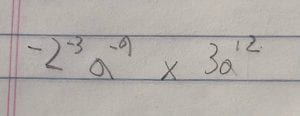This week in math 10, we started trigonometry, I think by far the most important thing we learned was the mnemonic device known as SOH CAH TOA which helps with finding the angle of a triangle. I will show you 2 examples where SOH CAH TOA shows us which sign to use on our calculator.
Example 1:

The first is to name each line using the letters A, H, and O. You want to put the H on the longest line which in this example would be the line with 16.5. Next, put the O on the opposite side of the angle so in this case, the opposite side of the 38 is on the right line so you would put an O there. Lastly, put the A on the one with no number and in this case, would be the line with the letter D.

After naming each then that is when SOH CAH TOA comes in handy. You want to ignore the letter on a line with no numbers or letters, in this case, O. And then look in SOH CAH TOA for which has an A and an H, which would be CAH. Now you know to use cos (cosine) on your equation and calculator. Now you want to write your equation like this:

Now you want to put the 16.5 on top. But it needs to now go before the COS so you would rewrite your equation like this.

Now put 16.5 cos 38 into your calculator and you should have the answer of 13.
Example 2:
This time let’s do an equation with sin instead of cos. It’s basically the same steps just with different numbers.

First, just like before we want to name each line.

Then using SOH CAH TOA we see that we need one with H and O which is SOH. Now write your equation using sin. Just like before, put the number above and at the front and put it into your calculator and you will have your answer.

And that’s all you need to do


















